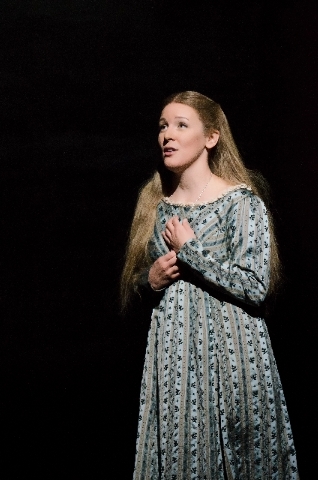Tweaks to ‘Les Mis’ change touring version
It ain’t broke.
How could it be, after a quarter-century as “the world’s most popular musical”?
Yet the creative team behind “Les Miserables’ ” 25th-anniversary tour — which opens an eight-performance run Wednesday at The Smith Center’s Reynolds Hall — fixed it anyway.
OK, maybe not “fixed.”
But “you develop your own way of doing things,” explains Laurence Connor , co-director of the current “Les Mis” tour.
For Connor and co-director James Powell, doing things their way meant the following: “Look at the piece again, take it right back to the book — and forget there ever was a production,” Connor says.
Not an easy thing to do, considering that 65 million people in 42 countries have seen “Les Miserables” onstage. (To say nothing of the millions who caught the 2012 movie adaptation.)
But “the wonderful thing about the piece,” in Connor’s view, is that “the show has room for different visions.”
And, make no mistake, this “Les Mis” represents a different vision than the Tony-winning original. (The touring version of that production played Las Vegas’ Cashman Theatre in 1993.)
Inspired by Victor Hugo’s sprawling 1862 novel of suffering and salvation in 19th-century France, “Les Mis” features more than Hugo’s narrative this time around.
The current tour also takes its visual cues from Hugo, who began drawing as a hobby and eventually created more than 3,000 works he kept out of the public eye so as not to distract, or detract, from his literary output.
But Hugo’s modernistic pen-and-ink images, translated into projected backdrops by set designer Matt Kinley , “bring the whole thing together,” Connor says.
“By actually seeing Victor Hugo’s paintings, there’s a vision — how he saw the characters themselves,” he explains. “It’s not just his story” onstage, “but his actual vision as well.”
Using Hugo’s drawings as a visual motif, however, meant discarding one of the original production’s signature elements: its Tony-winning turntable set. (Which was designed by John Napier, whose credits range from Broadway’s “Cats” to Siegfried and Roy’s 1990s Mirage spectacular.)
The turntable may have served as an effective metaphor for “Les Mis” at one time, but without that trademark hardware the musical “becomes less about the turntable and more about the people in the story and the clarity of the narrative,” Connor says.
That narrative begins in 1815, as embattled protagonist Jean Valjean (played by Peter Lockyer ) is finally paroled after 19 years on a chain gang. (His crimes? Stealing a loaf of bread to feed his sister’s starving family — and trying to escape.)
Valjean’s odyssey concludes 17 years later, during the ill-fated student uprising of 1832, when Valjean saves the life of Marius (Devin Ilaw ), the idealistic activist his adopted daughter Cosette (Lauren Wiley ) loves.
In between, an epic cat-and-mouse chase finds Valjean trying to elude the relentless police Inspector Javert (Andrew Varela ), who’s been chasing Valjean since he broke parole following his release from prison.
Despite the central Valjean-vs.-Javert conflict, “it’s such a strong ensemble piece,” Connor says of the show. “You feel like you’re watching a world” come to life.
Much of that world unfolds through “Les Miserables’ ” musical score, created in 1979 by the French team of composer Claude-Michel Schonberg and writer Alain Boublil . (Herbert Kretzmer wrote the lyrics for the English-language production that launched the musical’s record-setting run.)
“The score is quite extraordinary,” Connor notes — but not so extraordinary that it didn’t require some adjustment.
All the music accompanying the turning of the original’s turntable, for example, “didn’t work with our set,” the director says.
And when Connor first approached the composer, Schonberg told the director, “ ‘You tell me which music you want to cut — and I will tell you why you can’t cut it,’ ” Connor recalls with a chuckle. In the end, however, “he was very reasonable — and very onboard with it.”
Perhaps that’s because there’s still plenty of music to power the story, from the stirring “Do You Hear the People Sing?” to the poignant “I Dreamed a Dream,” which Connor cites as a particular favorite.
Sung by the doomed Fantine (Genevieve Leclerc ), who recalls how love has turned to heartbreak, the song may be “tragic, but there’s still hope at the end of it,” he points out. (Just ask singer Susan Boyle, whose rendition on “Britain’s Got Talent” transformed her from unlikely unknown to international sensation.)
Connor began his “Les Mis” immersion 15 years ago as a member of the show’s ensemble, where he first observed the power of its “story of the human heart” — from love to anguish and everything in between.
“The stories” the musical tells “are so real,” he says. “The music has a personal effect on individuals.”
And while this 25th-anniversary production stands as 2013’s definitive “Les Mis,” the show is hardly a set-in-stone artifact, Connor says.
“In 10 or 20 years’ time, two new directors with a completely new vision” will deliver their “Les Mis,” he says. “The show deserves to live on in the hearts of the people.”
Contact reporter Carol Cling at ccling@
reviewjournal.com or 702-383-0272.
Preview
"Les Miserables"
7:30 p.m. Wednesday and Thursday; also 2 and 7:30 p.m. Aug. 9-11
Reynolds Hall, The Smith Center for the Performing Arts, 361 Symphony Park Ave.
$31-$153 (702-749-2000, www.thesmithcenter.com)























